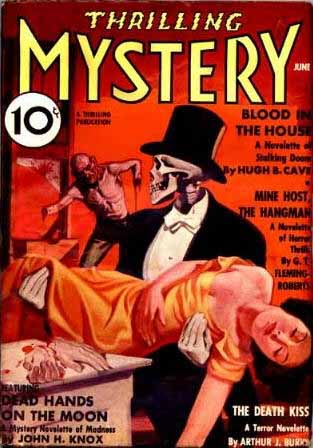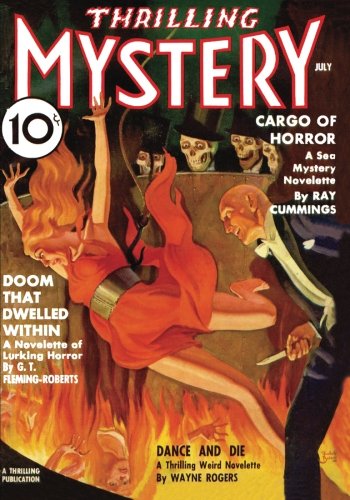
A Black Wind Blowing: Robert E. Howard and The Weird Menace Horror Pulps
by Ryan Harvey
Robert E. Howard was a pulp professional, always searching for new markets to sell his fiction. Unlike his friends in the Weird Tales bullpen, H. P. Lovecraft and Clark Ashton Smith, both of whom kept to a narrow fictional style and a handful of magazines, Howard experimented to target different markets. Sometimes the experiments were a bust. He sold a few straightforward detective yarns to low-paying pulps before abandoning the genre (“I can scarcely endure to read one, much less write one”). Other times he scored huge successes, such as his Appalachian Western-comedies for Action Stories.

Howard made brief ventures into two odd niches of the 1930s pulps, the “spicys” and the “weird menace” magazines. The sex-filled spicys deserve their own article some day. The tale of the weird menace pulps is its own mini-epic that could only have risen out of the anything-goes mentality of the Golden Age of the pulps.
The term “weird menace” was given to these pulps by later popular culture scholars. At the time, the magazines were referred to as “horror pulps.” This wasn’t an inclusive horror, but a specific subset with its own formula. The best way to understand what weird menace is about is to imagine a three part mixture: the action-speed of pulp detective stories; the mood and settings of Gothic novels; and the bloody excess of the Grand Guignol theater of Paris.
In fact, Grand Guignol was a direct influence on the godfather of weird menace, publisher Harry Steeger of Popular Publications. The Grand Guignol nightly staged graphic horror plays that used stage trickery to depict beheadings, eye gouging, brain surgery, disfigurements, and other shockers—rarely with any supernatural elements. Steeger borrowed this melodramatic formula and assigned editor Rogers Terrill to use it to transform an anemic detective pulp, Dime Mystery. In October 1933, Dime Mystery became the home of lurid thrillers filled with outlandish murders, demented cults, and deformed torturers.

The public loved it. Dime Mystery’s circulation surged, and Popular Publications created two new magazines in the same style: Terror Tales and Horror Stories. Other publishers leaped aboard the gore-train. The most successful was Thrilling Mystery from Better Publications. Spicy Mystery merged weird menace with the sex magazines, pushing the sexual sadism that was already a genre undercurrent.
The typical weird menace story features a young couple who falls into the crimson clutches of cultists or other assorted groups of madmen. After a liberal application of bizarre murder methods, torture, and disfigured monstrosities, the story concludes with an attempt to wrap everything in a rational explanation and hand-wave away the supernatural. This usually required the writer to perform plot gymnastics or rely on outlandish inventions and science that were often less believable than demons and vampires.
At their worst, weird menace stories are a tiresome parade of extremes slapped onto the page by a writer in need of a fast paycheck. At their best, in the hands of skilled authors who dove into the insanity of the form, weird menace stories are gripping, feverish, almost absurdist horror masterpieces.
High-output pulp pros dominated Dime Mystery and its siblings. Wyatt Blassingame, Hugh B. Cave, and Arthur J. Burks were the most prolific weird menacers and some of the best. Cornell Woolrich, a suspense writer whose personal sense of doom and paranoia made him uniquely qualified for the style, produced two weird menace masterpieces: “Graves for the Living” and “Dark Melody of Madness,” the second of which broke the formula by ripping away the rational explanation at the last moment, leaving readers over a black pit.

Robert E. Howard submitted several stories to the horror pulps, but only two ended up published in the magazines: “Black Wind Blowing” and “Graveyard Rats” appeared in Thrilling Mystery in 1936.
These two stories are fine examples of weird menace, although compared to much of Howard’s output they’re middling. Both take place in Texas post oak country. In “Black Wind Blowing” hero Emmett Glanton must rescue a beautiful, frail young woman from the Black Brotherhood of Ahriman. The ambiguously foreign cult has come to exact revenge on the girl’s uncle, a renegade member. Perfect weird menace formula, and Howard follows through with all the expected gory details: a decapitated head on a spike, a man staked down to a table and his tongue mutilated, a killer with filed teeth and a metal clawed glove, and a deformed brute. The “rational” explanation for the magical blue energies of the Brotherhood is a super-powered electrical dynamo—which of course fries a few people to blackened husks before the end. Howard keeps the story together with an aura of hovering doom, expressed through the sinister touch of the winds of the title.

“Graveyard Rats” goes further. Howard uses a serial character, Steve Harrison, who made a few appearances in obscure detective pulps. Harrison is bland, but the story is a grisly roller coaster ride about a blood feud among Texan families and a murder mystery that may involve the ghost of a wrathful Tonkawa chief. Steve Harrison still must explain numerous plot convulsions to make sense of the reveal of the killer, but he does it in the middle of a burning house while hordes of ravenous rats swarm over the villain, turning him into—well, Howard’s description isn’t pretty, let’s put it that way. “Graveyard Rats” is crammed with memorable nastiness and enough of Howard’s touch of conviction to make it work as something other than mere lunacy.
Now that I think of it, “mere lunacy” is a succinct description of most weird menace stories.
The horror pulps burned out before the end of the decade. Some magazines changed to new formulas, others dropped the sexual sadism. A predictable moral outrage by censors also cut into the market. By the time the US entered World War II, the weird menace era was over. Its mere lunacy couldn’t compete against the real thing.
Ryan Harvey is a professional marketing writer who dwells in the sun-drenched decadence of Southern California with his black cat familiar. He won the Writers of the Future Contest in 2011 and has written numerous essays for www.blackgate.com on his wide-ranging fascinations: Godzilla, Edgar Rice Burroughs, and any movie starring Peter Cushing. When he isn’t writing he is—for some unfathomable reason—an improvisational comedy performer with a local theater. Find if he has anything interesting to say at www.RyanHarveyAuthor.com.
Be sure to check out the gamut of Sword and Sorcery fiction in the pages of Tales From The Magician’s Skull!

Stay connected with us on social media platform for instant update click here to join our Twitter, & Facebook
We are now on Telegram. Click here to join our channel (@TechiUpdate) and stay updated with the latest Technology headlines.
For all the latest Gaming News Click Here
